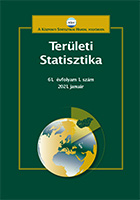A hazai COVID–19-járványhullámok területi különbségei
Regional inequalities in the waves of the COVID-19 pandemic in Hungary
Author(s): Annamária Uzzoli, Sándor Zsolt Kovács, Balázs Páger, Tamás SzabóSubject(s): Social Sciences, Economy, Geography, Regional studies
Published by: Központi Statisztikai Hivatal
Keywords: COVID-19; pandemic; epidemic waves; regional inequalities; Hungary
Summary/Abstract: The COVID-19 epidemic first appeared atthe end of 2019, and it became a worldwide pandemic in the first quarter of 2020. The new coronavirus pandemic made it clear that infectious diseases are able to significantly influence morbidity and mortality data of countries in the 21st century, too. There are many complex and profound socio-economic consequences of the restrictions in relation to the coronavirus pandemic. This epidemic also resulted in an economic crisis with multiple effects on the economy and society. It is said that spatiality has a determinative role in the geographical spreading of the pandemic and on regional differences of the economic crisis. The scope of this paper is to compare the most important features and regional inequalities of the epidemic waves in Hungary based on epidemiological data. Besides statistical analysis, the study examines short-, medium and long-term effects of the pandemic on health and health care, too. The literature review presents some regional features of the coronavirus epidemic, and it also defines the role of this pandemic on non-communicable diseases for the future. The used content analysis investigates the Hungarian restrictions and their regional relevance. The main results of our research show that there are marked differences between the three epidemic waves in Hungary based onthe number of confirmed cases and regional inequalities regarding restrictions. There was a longer interim period during the summer between the two epidemic waves of spring and autumn of 2020. On the other hand, the longer improving tendency of the second wave suddenly stopped in mid-February 2021 resulting in a third epidemic wave in Hungary. The first wave was a ’flat curve’ while the second wave resulted in an epidemic plateau. The third wave started during the decreasing process of the second wave. The first wave was more linked to geographical (Budapest capital city and Pest county) and institutional (hospitals, nursing homes) hotspots,however in the second and third wave nationwide infection ranges became more determinative. The results of our research call the attention to the regional relevance of restrictions regarding the pandemic. When this paper was finished, on the 4th of March 2021, the pandemic did not end yet in Hungary, so its evaluation can not be complete at this time. The ascending trend of the third wave of the COVID-19 pandemic is due to the spreading of new coronavirus variants and mutations.
Journal: Területi Statisztika
- Issue Year: 62/2021
- Issue No: 03
- Page Range: 291-319
- Page Count: 29
- Language: Hungarian

